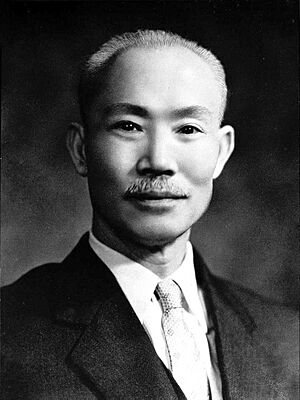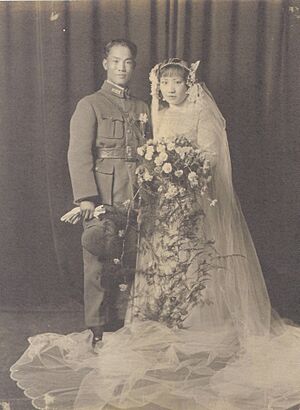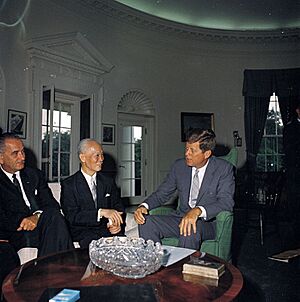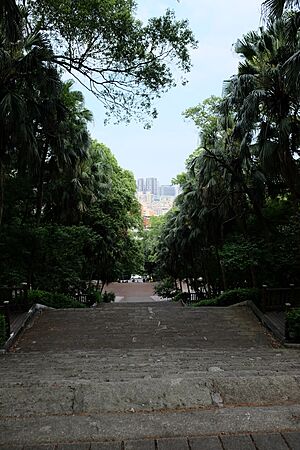Chen Cheng facts for kids
Quick facts for kids
Chen Cheng
|
|
|---|---|
|
陳誠
|
|
 |
|
| 2nd Vice President of the Republic of China | |
| In office 20 May 1954 – 5 March 1965 |
|
| President | Chiang Kai-shek |
| Preceded by | Li Zongren |
| Succeeded by | Yen Chia-kan |
| Premier of the Republic of China | |
| In office 30 June 1958 – 15 December 1963 |
|
| President | Chiang Kai-shek |
| Vice Premier | Huang Shao-ku Wang Yun-wu |
| Preceded by | Yu Hung-chun |
| Succeeded by | Yen Chia-kan |
| In office 7 March 1950 – 7 June 1954 |
|
| President | Chiang Kai-shek |
| Vice Premier | Chang Li-sheng Huang Shao-ku |
| Preceded by | Yan Xishan |
| Succeeded by | Yu Hung-chun |
| 2nd Chairman of Taiwan Provincial Government | |
| In office 5 January 1949 – 21 December 1949 |
|
| President | Chiang Kai-shek Li Zongren (acting) |
| Preceded by | Wey Daw-ming |
| Succeeded by | Wu Kuo-Chen |
| 1st Chief of the General Staff of the Republic of China Armed Forces | |
| In office 23 March 1946 – 12 May 1948 |
|
| President | Chiang Kai-shek |
| Preceded by | Position established |
| Succeeded by | Gu Zhutong |
| 1st Commander-in-Chief of the Republic of China Navy | |
| In office 1 July 1946 – 25 August 1948 |
|
| President | Chiang Kai-shek |
| Preceded by | Position established |
| Succeeded by | Kui Jung-ching |
| Personal details | |
| Born | January 4, 1898 Qingtian, Zhejiang, Qing Empire |
| Died | March 5, 1965 (aged 67) Taipei, Taiwan |
| Nationality | Republic of China |
| Political party | Kuomintang |
| Spouse | Tan Xiang |
| Relations | Tan Yankai (father-in-law) |
| Children | Chen Li-an |
| Occupation | General, politician |
| Awards | Order of Blue Sky and White Sun |
| Nickname | "Little Generalissimo" |
| Military service | |
| Allegiance | |
| Branch/service | |
| Years of service | 1924–1950 |
| Rank | |
| Unit | 11th division |
| Commands | 18th Army 11th Division |
| Battles/wars |
|
Chen Cheng (born January 4, 1898 – died March 5, 1965) was an important Chinese military and political leader. He was a main commander in the National Revolutionary Army during two major conflicts: the Second Sino-Japanese War and the Chinese Civil War.
After the civil war ended, Chen Cheng moved to Taiwan. There, he served in several high-ranking government jobs. He was the Governor of Taiwan Province, the Vice President, and the Premier of the Republic of China (ROC). He also visited the United States to represent the ROC. Chen Cheng helped start important changes in Taiwan, like land reforms and tax cuts. These changes made it possible for farmers to own land, which helped make Taiwan a stronger and more stable place.
Contents
Early Life and Military Beginnings
Chen Cheng was born in Qingtian County, Zhejiang province. He finished his studies at the Baoding Military Academy in 1922. Two years later, he joined the Whampoa Military Academy. This is where he first met Chiang Kai-shek, who was the head of the Academy.
Later, Chen Cheng joined the National Revolutionary Army. He took part in the Northern Expedition, a military campaign to unite China.
Rising Through the Ranks
During the Northern Expedition, Chen Cheng showed great skill as a leader. He was quickly promoted from leading small groups of soldiers to commanding entire divisions within just one year.
After the expedition, Chen Cheng continued to be successful in battles against powerful local warlords. His victories led to even more promotions. He eventually became the commander of the important 18th Army.
Fighting Against Communists
In 1931, Chen Cheng was given the job of fighting against the Red Army, a communist military force. His units faced tough battles and suffered many losses while trying to find the main Red Army forces.
In a major campaign against the Communists, Chen Cheng finally managed to defeat them. This defeat forced the Red Army to begin its famous Long March, a long and difficult retreat. The fighting against the Red Army stopped after the Xi'an Incident. In this event, Chiang Kai-shek and his team agreed to work with the Communists to fight against the invading Imperial Japanese Army.
War Against Japan
During the Battle of Shanghai, Chen Cheng was one of Chiang Kai-shek's top military advisors. He suggested focusing the fight against Japan in Southern China. This was because the Nationalist troops in Northern China were not well-equipped.
After Shanghai and Nanjing fell to the Japanese, Chen Cheng moved to Hubei. There, he led the Battle of Wuhan in 1938. Wuhan was a temporary headquarters for the Chinese Army. Even though the Japanese suffered heavy losses, they managed to defeat the Chinese and captured Wuhan in October 1938.
In the later years of the war, Chen Cheng commanded troops in several other important battles. These included the Battle of Changsha, the Battle of Yichang, and the Battle of West Hubei. In 1943, he was put in charge of the Chinese Expeditionary Force in the Burma Theater. He was later replaced due to illness.
Chinese Civil War
After the Second Sino-Japanese War ended, Chen Cheng became the Chief of the General Staff. He also became the commander-in-chief of the navy. Following Chiang Kai-shek's orders, he began to attack areas held by the Red Army. This started the Chinese Civil War.
In August 1947, Chiang Kai-shek made Chen Cheng the director of the Northeastern Headquarters. His job was to lead the Nationalist forces against the Communists in that region. He made some difficult decisions, which led to several defeats for the Nationalist forces. Because of these losses, Chiang Kai-shek called Chen Cheng back to Nanjing. Chen Cheng then took a break in Taiwan to recover from a stomach illness.
Life and Work in Taiwan
In 1949, Chiang Kai-shek appointed Chen Cheng as the Governor of Taiwan Province. His task was to help Taiwan grow and become a strong base for the Nationalist government. After the Nationalist forces moved to Taiwan, Chen Cheng held many important government jobs. He became the Vice-Executive of the Kuomintang party, the Vice President, and the Premier of the Republic of China. He was the youngest premier to hold office since the 1947 constitution was put in place.
During his time in Taiwan, Chen Cheng introduced many land and economic changes. He also helped rebuild Taiwan. One of his most important actions was the 37.5% Arable Rent Reduction program. This program limited the rent farmers had to pay landlords to 37.5% of their harvest. Before this, landlords often demanded more than half of the crops. This policy helped farmers own their land and was important in preventing the spread of communism in Taiwan.
He also started several big building projects. One example is the Shimen Reservoir in Taoyuan County. This reservoir helped reduce flooding and increased the amount of rice grown.
On May 19, 1949, Chen Cheng announced martial law across Taiwan. This was done to stop communist activities and to strengthen Taiwan's defenses.
Death
Chen Cheng passed away in 1965 from a liver illness. His remains were later moved to Fo Guang Shan in Kaohsiung County (now part of Kaohsiung City) in August 1995.
Honors
- Key to the City
 Manila, Philippines (March 20, 1960)
Manila, Philippines (March 20, 1960)- Pasay City, Philippines (March 20, 1960)





